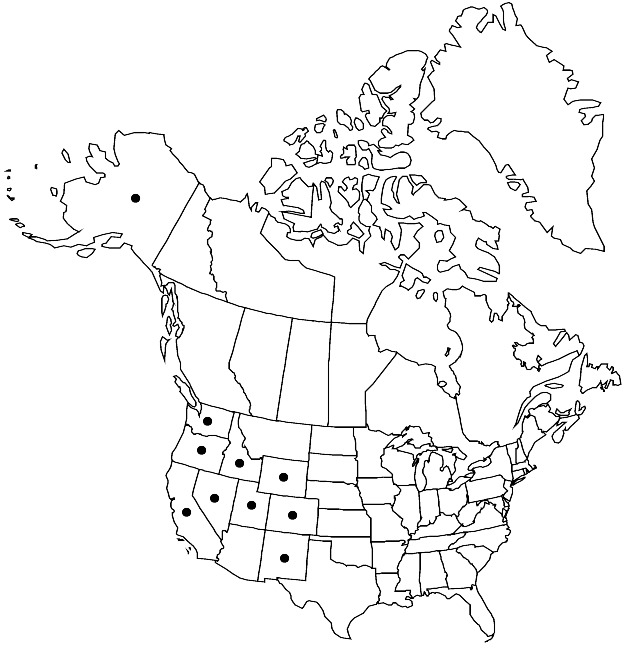Difference between revisions of "Pohlia tundrae"
Bryologist 84: 65, figs. 1 – 10. 1981.
FNA>Volume Importer |
imported>Volume Importer |
||
| (6 intermediate revisions by 2 users not shown) | |||
| Line 23: | Line 23: | ||
|elevation=low to high elevations | |elevation=low to high elevations | ||
|distribution=Alaska;Calif.;Colo.;Idaho;Nev.;N.Mex.;Oreg.;Utah;Wash.;Wyo.;Europe. | |distribution=Alaska;Calif.;Colo.;Idaho;Nev.;N.Mex.;Oreg.;Utah;Wash.;Wyo.;Europe. | ||
| − | |discussion=<p>Pohlia tundrae has linear to oblong gemmae that extend widely from the distal leaf axils and develop in clusters, sometimes densely. The leaf primordia are broadly laminate and flexuose. Lax plants from shaded microsites have narrow pale to whitish gemmae, but plants from more exposed sites have thicker, sometimes reddish gemmae that can appear similar to those of P. drummondii. At high elevations in Yosemite National Park, P. tundrae grows mixed with P. drummondii and the two appear to intergrade, but such intermediate plants have not been seen elsewhere. Occasional plants with very short gemmae can be confused with P. proligera, which typically has smaller, vermicular gemmae with peglike apical leaf primordia.</p> | + | |discussion=<p><i>Pohlia tundrae</i> has linear to oblong gemmae that extend widely from the distal leaf axils and develop in clusters, sometimes densely. The leaf primordia are broadly laminate and flexuose. Lax plants from shaded microsites have narrow pale to whitish gemmae, but plants from more exposed sites have thicker, sometimes reddish gemmae that can appear similar to those of <i>P. drummondii</i>. At high elevations in Yosemite National Park, <i>P. tundrae</i> grows mixed with <i>P. drummondii</i> and the two appear to intergrade, but such intermediate plants have not been seen elsewhere. Occasional plants with very short gemmae can be confused with <i>P. proligera</i>, which typically has smaller, vermicular gemmae with peglike apical leaf primordia.</p> |
|tables= | |tables= | ||
|references= | |references= | ||
| Line 32: | Line 32: | ||
-->{{#Taxon: | -->{{#Taxon: | ||
name=Pohlia tundrae | name=Pohlia tundrae | ||
| − | |||
|authority=A. J. Shaw | |authority=A. J. Shaw | ||
|rank=species | |rank=species | ||
| Line 47: | Line 46: | ||
|publication year=1981 | |publication year=1981 | ||
|special status= | |special status= | ||
| − | |source xml=https:// | + | |source xml=https://bitbucket.org/aafc-mbb/fna-data-curation/src/2e0870ddd59836b60bcf96646a41e87ea5a5943a/coarse_grained_fna_xml/V28/V28_324.xml |
|genus=Pohlia | |genus=Pohlia | ||
|species=Pohlia tundrae | |species=Pohlia tundrae | ||
Latest revision as of 21:35, 5 November 2020
Plants small to medium-sized, green to light green, glossy. Stems 0.5–2.5 cm. Leaves ± spreading, lanceolate to ovate-lanceolate, 0.9–1.5 mm; margins serrulate to serrate in distal 1/3; costa subpercurrent; distal medial laminal cells rhombic to rhomboidal, 45–95 µm, walls thin. Specialized asexual reproduction usually present when sterile; axillary gemmae 2–8, elongate, extending beyond leaves, yellow, pink, or green, leaf primordia at apex and lower, laminate. Sexual condition dioicous; perigonial leaves ovate; perichaetial leaves scarcely differentiated, ovate-lanceolate. Seta orange-brown. Capsule inclined 95–180°, brown to stramineous, pyriform, neck 1/3 urn length; exothecial cells short-rectangular, walls sinuate; stomata superficial; annulus present; operculum convex-conic; exostome teeth yellow-brown, narrowly triangular-acute; endostome hyaline, basal membrane 1/2 exostome length, segments distinctly keeled, broadly perforate, cilia short to rudimentary. Spores 16–23 µm, finely roughened.
Phenology: Capsules mature summer (Jun–Aug).
Habitat: Acid, relatively humus-rich soil, alpine tundra, stream banks, path banks, heavy metal mine tailings
Elevation: low to high elevations
Distribution

Alaska, Calif., Colo., Idaho, Nev., N.Mex., Oreg., Utah, Wash., Wyo., Europe.
Discussion
Pohlia tundrae has linear to oblong gemmae that extend widely from the distal leaf axils and develop in clusters, sometimes densely. The leaf primordia are broadly laminate and flexuose. Lax plants from shaded microsites have narrow pale to whitish gemmae, but plants from more exposed sites have thicker, sometimes reddish gemmae that can appear similar to those of P. drummondii. At high elevations in Yosemite National Park, P. tundrae grows mixed with P. drummondii and the two appear to intergrade, but such intermediate plants have not been seen elsewhere. Occasional plants with very short gemmae can be confused with P. proligera, which typically has smaller, vermicular gemmae with peglike apical leaf primordia.
Selected References
None.